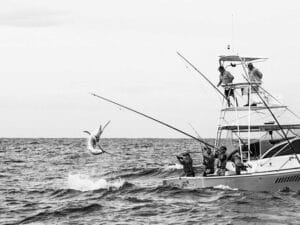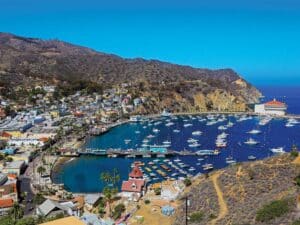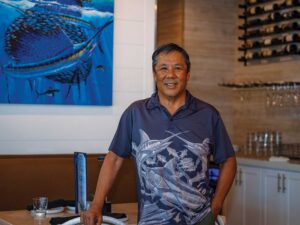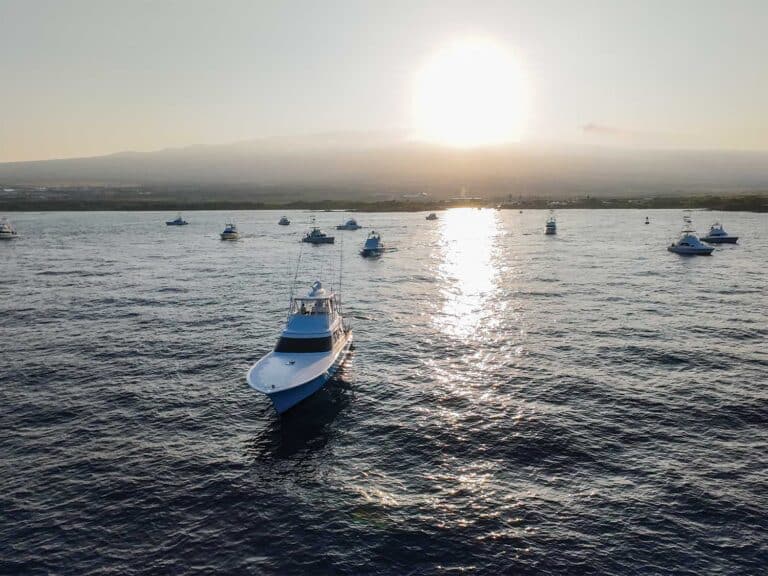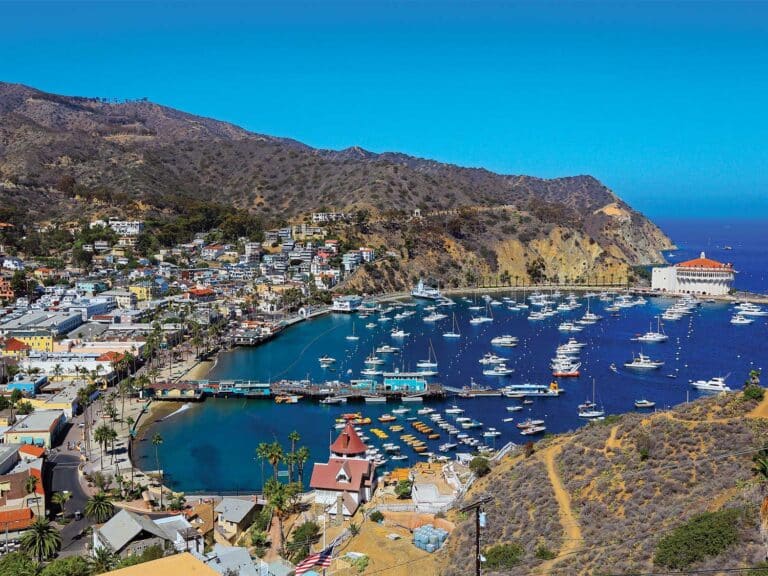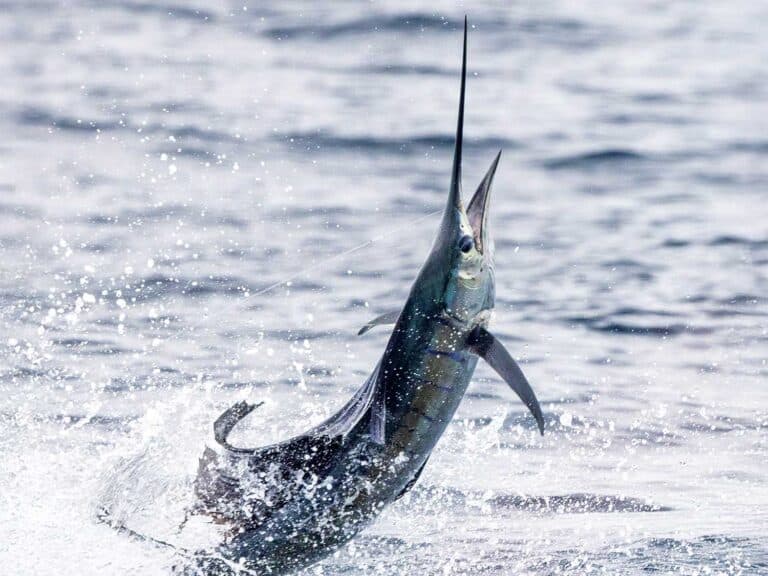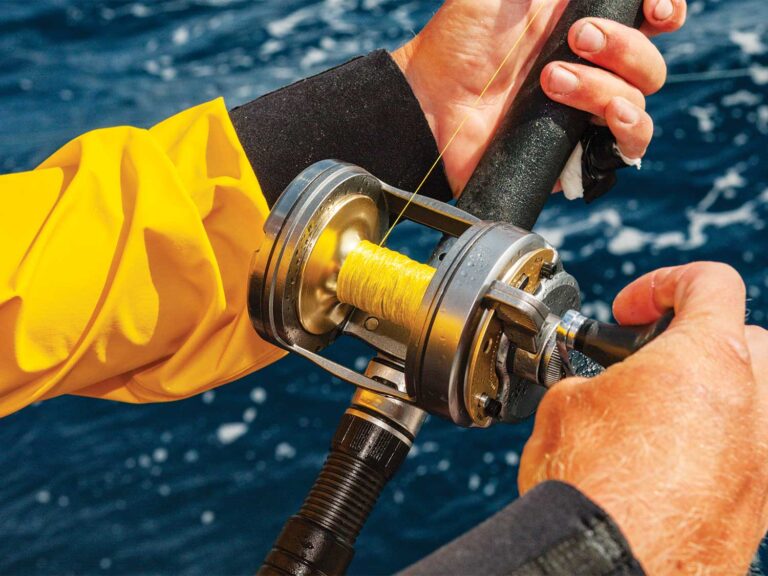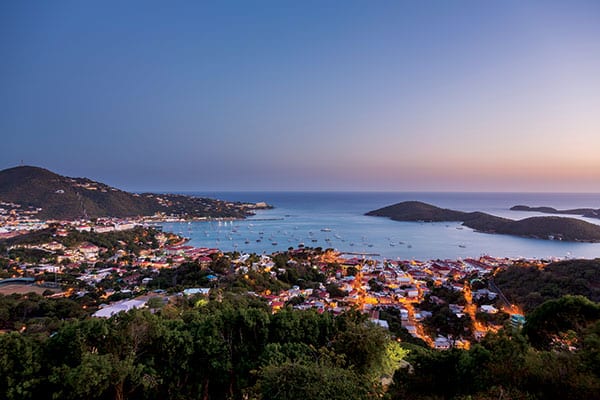
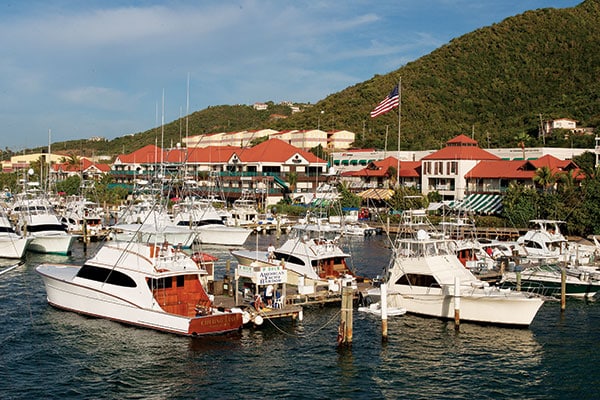
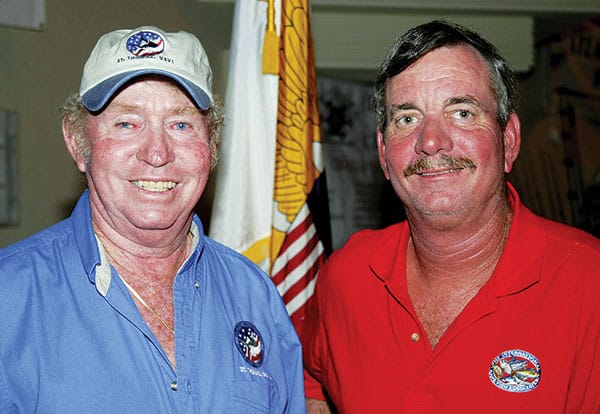


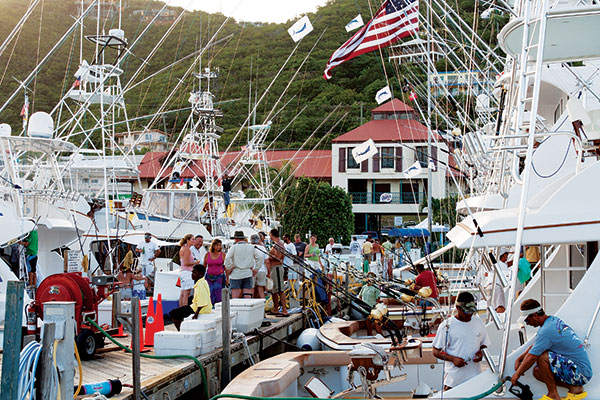

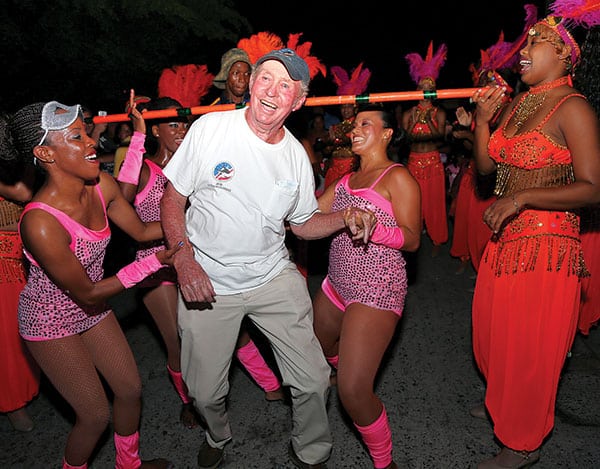
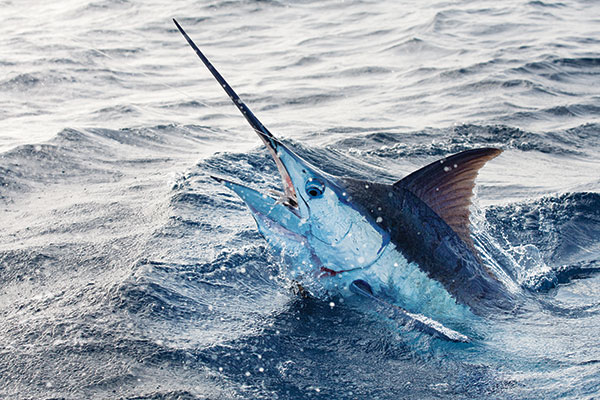
Although he would argue otherwise, Jimmy Loveland has put the USVI Open/Atlantic Blue Marlin, aka “Boy Scout,” Tournament on every big-game competitor’s bucket list. Along with his brother Stewart, who operates the island’s only big-game tackle store at Red Hook, Jimmy Loveland is the face of fishing in St. Thomas, U.S. Virgin Islands, and they are its unofficial ambassadors. With fat Rolodexes, they provide advice to visiting fishermen in need of everything from boat repairs and dockage to pickup mates, travel assistance, lodging and restaurant recommendations.
Known simply as Jimmy, Loveland has been a fixture in this scene since arriving here in 1964 to take a job as a mate for Capt. Johnny Harms, who discovered marlin fishing after catching the island’s first 169-pound blue in 1958 after running to the North Drop from San Juan, Puerto Rico. When Harms accepted land developer Laurance Rockefeller’s offer in 1962 to create a charter fishing enterprise at the family’s Caneel Bay Plantation resort on St. John, Loveland was one of the fishermen he hired to make it happen. Interested in blue marlin, Loveland was more than pleased by his decision to move to the Virgin Islands instead of Cat Cay, Bahamas. His first year there, Harms caught an 814-pound blue and set a world record on 80-pound tackle, the first of more than 15 set off St. Thomas.
Discovering St. Thomas
Harms recognized St. Thomas as a land of fishing opportunity, and Loveland and Palm Beach Capt. Jerry Black, who Harms had also recruited, followed the piper to St. Thomas that year, helping him create the island’s first marine facility, the Lagoon Marina, just a few miles from the town of Red Hook and present-day American Yacht Harbor, which Harms built in 1968. After running the facility for Harms for a while, Loveland became a partner with Black in the Lagoon Marina, the first of many enterprises he’s successfully run in St. Thomas.
Born and raised just south of Miami, the Loveland brothers come from a family that helped found Homestead, Florida, in 1908. “Our grandparents homesteaded 160 acres there under a federal grant, bringing farming and the railroad to the area,” Stewart Loveland says. Both grandparents were entrepreneurs, he adds. “My grandfather was an electrical contractor, who, with my grandmother, got involved in real estate investment and development.” Their father, however, was a fisherman, who, during his 30 odd years on Miami’s legendary Pier 5, owned and ran Polly D and Melody. “He docked next to old man [Vince] Spaulding, across from Capt. Buddy Carey on the SeaBoots,” Stewart Loveland says.
Those were colorful times, when anyone and everyone in fishing came to Pier 5, and that’s where Jimmy Loveland learned his trade. After graduating high school in 1960, the newly licensed captain headed to the Haulover Docks north of downtown Miami, where he freelanced as a mate and soon was hired by Vera and Ray Shand to help run Rave. In the summer of 1963, he took a seasonal job at Montauk, New York, with Capt. Jimmy Sarno and the Akins family on Nikka and got his first taste of surface-baiting swordfish, chumming for giant tuna and catching striped bass. There, he also met a captain he counts as a lifelong friend.
Old Friends Reunite
Capt. Ron Hamlin recalls meeting Loveland in 1963 as he was washing the tower of a boat in Montauk. They didn’t bump into one another again until 1972 in St. Thomas. “I’d just gotten in, and I’m looking down the dock, and there’s this skinny-as-a-rail, red-headed guy dressed head to toe in khaki walking towards me,” Hamlin says. “I looked at him and said, ‘Damn, I know you.’”
Loveland was running a tour with a former headboat from Miami, taking tourists out to see the sites. “Jimmy was quite the entrepreneur,” Hamlin says. “By then, he owned restaurants, his travel and tour businesses — Treasure Isle Cruises and Travel — and an airbrush company that sold T-shirts to tourists, plus the Imagine Advertising Agency. Jimmy has one of the most creative minds I’ve ever encountered. He was into everything when it came to promoting St. Thomas.”
The King of St. Thomas Fishing
Harms remains the undisputed father of Virgin Islands sport fishing, but as locals, including Capt. Mike Lemon, are quick to point out, Loveland has been more like its godfather, guiding the Boy Scout Tournament and creating everything from October Sunday to Marlin Fest.
After returning to Haulover Docks in the fall of 1963 with his new bride, Linda, Loveland met Harms. Loveland recognized Harms, who was standing on the dock waiting for him to tie up Rave. “I guess he’d been over talking to Buddy Carey on Pier 5, who recommended me to him as a mate for one of the two charter boats he was running in the Virgin Islands,” Loveland says. “At the time, I was considering a job on a boat fishing Cat Cay but when Johnny offered me the position, I said yes. Then I said, ‘Where are the Virgin Islands?’ ”
Arriving by air in January 1964, Loveland found Harms and his Savannah Bay sport-fisherman waiting to whisk him to St. John where paradise awaited. Fishing up to 250 days a year and exploring virgin fishing territory meant you never knew what the next day would bring, Loveland says. “Actors like David Janssen and famous politicians like Mo Udall, Lady Bird Johnson and Hubert Humphrey all sailed with us.” But by the late ’60s, Loveland was phasing out of day-to-day sport fishing to take care of business. He’d just sold his half interest in the Lagoon Marina to Black to fund his new venture taking cruise ship guests on guided tours to nearby sites.
Economic Opportunity
The first cruise ships -— Royal Caribbean’s Song of Norway and Nordic Prince -— arrived in 1968 and were followed by Carnival and others. Sensing economic opportunity, Loveland was the first to offer snorkeling tours to destinations like the Virgin Gorda baths that inspired Robert Louis Stevenson’s Treasure Island, St. John, Jost Van Dyke and some 50 other islands.
In Miami, Loveland purchased a wooden 54-foot headboat and talked Stewart Loveland into helping him pilot it from the States to St. Thomas. The boat was called Fish-N-Fool after the charter boat Jimmy Loveland ran at Lagoon Marina, and the brothers did a refit, adding sunshades, creature comforts and a big galley for lunches and snacks. The island’s first 49-passenger excursion boat was an instant success not only with tourists, but with locals jamming aboard Sundays for Loveland’s unscheduled “gunkholing” cruises to unexplored islands.
In 1974, he upgraded to a 76-foot catamaran, which he recently sold, along with Treasure Isle Travel, to devote himself full time not only to the Boy Scout and Spanish Main tournament series but also to Marlin Fest and yet another new tournament series he would like to start. For Loveland, business endeavors have always grown organically. Recognizing the coming tourist boom in the ’70s, he bought Sib’s on the Mountain Bar and added an outside dining area to the popular watering hole. Its success led him to open Sib’s on the Beach, which he sold in the early ’90s.
During this time, Loveland was a freelance captain for anglers like Winthrop Paul Rockefeller, bringing the young scion’s new 46-foot Bertram My Ladies Three from Miami to St. Thomas — again with Stewart Loveland riding shotgun. In 1973, Jimmy Loveland and Rockefeller won the second Boy Scout, known then as the Governor’s Cup. Designed to showcase the island’s great blue marlin fishing and to raise funds for the Virgin Islands Boy Scout Council, early tournaments were run by the Chamber of Commerce.
Name Change
Intent on turning the mostly local light-tackle billfish event into a world-class blue marlin tournament, Loveland changed the tournament’s name when he took over in 1980. “The Governor meant nothing,” Loveland says. “I wanted the Virgin Islands up front in the title, so we called it the United States Virgin Islands Open Atlantic Blue Marlin Tournament. With that being a mouthful to say, it became known as the Boy Scout because they are beneficiaries of all profits.”
To grow the tournament, Loveland needed to attract top Florida boats, which he knew had little interest in catching blue marlin on 12- and 20-pound tackle, even though there were 50- and 80-pound divisions. “It was a scoring nightmare,” he says. Creating the first set of what has universally come to be known as “Jimmy’s Rules,” he made it a 50-pound tackle tournament. Earlier tournaments were kill events, but to Loveland, the sight of 15 blue marlin hanging dead on a rack was offensive. He went with a modified release format (400-pound minimum) soon after taking command.
At the time, the Boy Scout was the first such marlin event to do so; today, it essentially is a release event since no fish other than a potential world record can be landed. From the beginning, the idea was controversial. To police it, Loveland added observers, tapping fishing experts, such as the late John Rybovich and Tommy Gifford and, more recently, Rick Alvarez and captains O.B. O’Brien and Bouncer Smith.
Trendsetting Event
Without question, the Boy Scout has had an impact on other tournaments. The success of the Boy Scout’s modified release format led other events to adopt the format even before federal minimum size limits went into effect. Contests like the International Billfish League and Capt. Bill Gooch’s Virginia Beach Red, White and Blue, along with Joan Vernon’s Presidential Challenge Tournament series, implemented many of the Boy Scout’s rules. Gooch, with Loveland helping to write the curriculum, went on to create the certified observer program in 2002 with the International Game Fish Association. Over the past 12 years, a database of a thousand certified observers has been created. These people are trained in safety, IGFA rules, species identification and fishing etiquette and are used by organizers to police big-game release events worldwide.
Most tournaments operate according to IGFA rules, but “Jimmy’s Rules” go well beyond. Loveland drafted a special set of regulations intended to create a tournament of the “highest integrity, affording experienced fishermen the opportunity to display their skills.” Without calling it such, he created a blue marlin contest that is the equivalent of Rybovich’s Masters Invitational Sailfish Tournament, Capt. Billy Borer says. “Like the Masters, there are time limits and anglers must switch sides on the hour to equalize opportunities for catching fish,” he says. “Lines are supplied, and just like the Masters, a release is counted when the swivel touches the rod tip. Jimmy also spells out what tackle and techniques can and cannot be used.”
Just the mention of the Boy Scout’s 12-page rule book elicits groans from captains like Eddie Herbert and Lemon, both of whom have fished the tournament for more than 20 years. Stewart Loveland, who operates Neptune Fishing Supplies at American Yacht Harbor, has heard it all. “When someone starts ranting about the rules I just say, ‘no comment,’ ” he says.
An Angler’s Tournament
What people don’t get, Borer says, is this is an angler’s tournament. “Sure the big money (up to $500,000) goes to the top boat, and there’s also a crew division, but the way the rules are crafted makes it an angler’s tournament,” Borer says. “Jimmy’s viewpoint is anglers are the most important element, which is why the rules reinforce angling fairness. That’s kind of unique anymore because most competitions are now team or boat tournaments.”
“My chief gripe with the Boy Scout is that the rules are too complicated,” says Herbert, who started fishing the tournament in the late ’90s on Reel Tight with Jim Lambert. A member of the tournament’s board of captains, he says Jimmy Loveland runs a dictatorship. “I’m on the rules committee, so I can tell you Jimmy may listen to our suggestions, but he does what he thinks is right for the tournament, even though we tell him the best thing for the Boy Scout would be to simplify the rules. Jimmy wants to leave a legacy. He wants the Boy Scout to be the most challenging big-game tournament in the world, which it is.”
The most successful captain in the 42-year history of the Boy Scout, with four top boat wins on Revenge and one on Alchemist along with three winning anglers — Rockefeller (once), Sam Jennings (three times) and Jon Jennings (twice) — Lemon understands the rules better than most. “Jimmy is not swayed by what captains think of his rules, but you gotta give him credit,” Lemon says. “When blue marlin fishing was evolving from high-speed lures to pitch baiting in the 1990s, Jimmy took our input and eventually incorporated it into the rules after seeing it in practice.” Because pitching is so specialized and favors anglers with better skills, most captains favor the best available angler, Loveland says. So it took a while for him to devise a formula making it fair for all anglers on board.
Supporting the Scouts
Building the Boy Scout Tournament has been a laborious job. “A lot of years, we sweated about making expenses and giving the Boy Scout Council a nice donation,” says Sue Bolland, who has worked alongside Loveland as a volunteer on the committee since the start. “It took years for us to go from 12 to 20 to a high of 46 boats, which we hit in 2004 before the economic recession. That year, we raised more than $125,000 for the Boy Scouts.”
After contributing more than $1.9 million to local Boy Scout and youth programs, it could be easy for Loveland to stick with the status quo, but that’s not his way of doing things. Through the online ABMT newsletter and print magazine, On the Edge, and the Miami International Boat Show’s Big Game Room, a concept he dreamed up and made happen 11 years ago, Loveland publicizes new and exciting promotions for his adopted homeland.
The latest brainstorm is Marlin Fest, which Loveland launched last year as a three-day spectator event to showcase the Boy Scout Tournament. Included in Marlin Fest is the Center Console Sportfishing Tournament, which focuses on near-shore fishing for sailfish, white marlin, wahoo and other species. Loveland sees great potential in this one-of-a-kind celebration of sport fishing and area outdoor activities. Loveland’s Marine Vocational Program started in his own pool and has grown from there. “The idea of the MVP was to give young islanders with little economic hope the tools to become licensed captains, boat designers, SCUBA instructors and more,” he says.
USVI Promoter
“No one does more to promote the Virgin Islands, big-game fishing and the Boy Scout than Jimmy,” Herbert says. “Every night, he’s walking the dock, collecting fishing reports to post on his website for readers to get them interested in coming here to fish. Even when he was fighting cancer two years ago, every night he’d be snapping pictures and writing his report. He’s the most energetic SOB I’ve ever met.”
In spite of occasional spats, no one admires Loveland more than his brother Stewart Loveland. “The Boy Scout Tournament would not be here without him, and without the Boy Scout, Red Hook would not be what it is today,” he says. “Jimmy took it up and just ran with it, making it an international success.” Even more amazing to Stewart Loveland is that his brother has accomplished this as a volunteer. “People think he gets a salary, but outside of travel and phone expenses, my brother has never collected a dime for the time he puts in promoting the island and tournament. When I hear people talking trash about the rules, I attribute it to a lack of knowledge. I can’t think of anyone that’s done more to promote big-game fishing than my brother.”
As the Boy Scout celebrates its 42nd anniversary and Jimmy Loveland’s 32nd as its mastermind in August, it can be said that 50 years after Loveland’s arrival, big-game fishermen have him to thank for teaching them about the Virgin Islands and its world-class run of blue marlin during the full moons between July and October.

